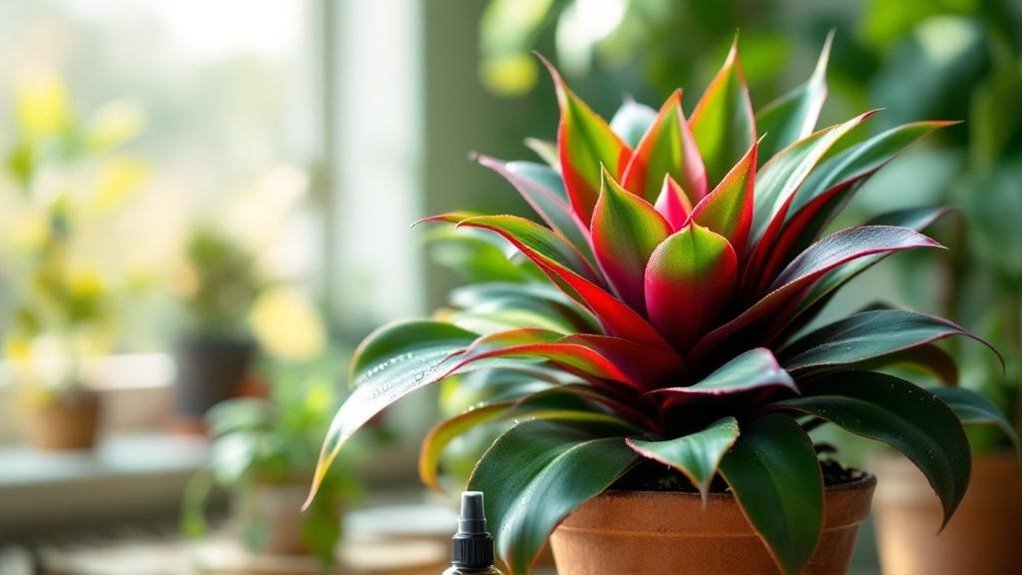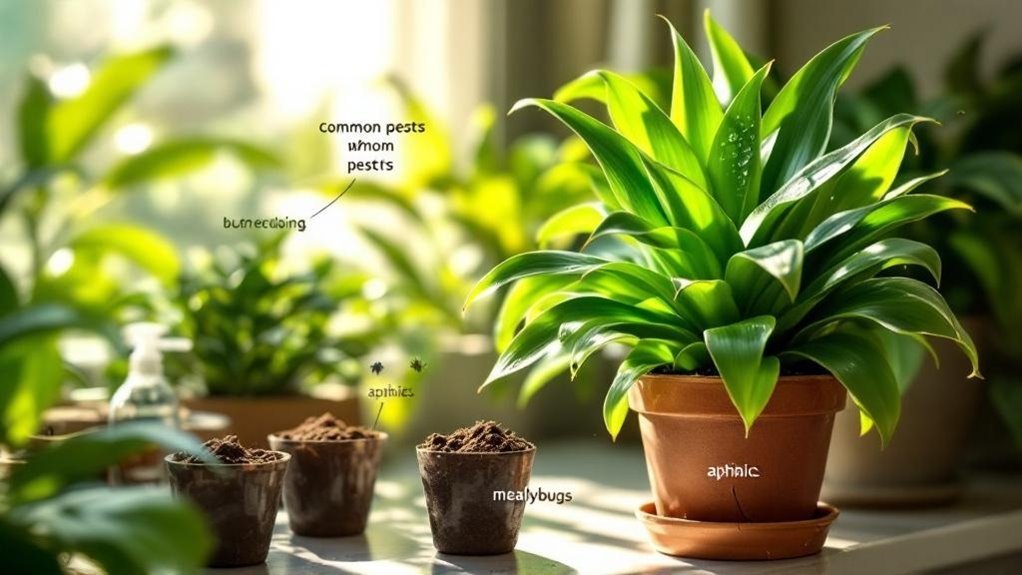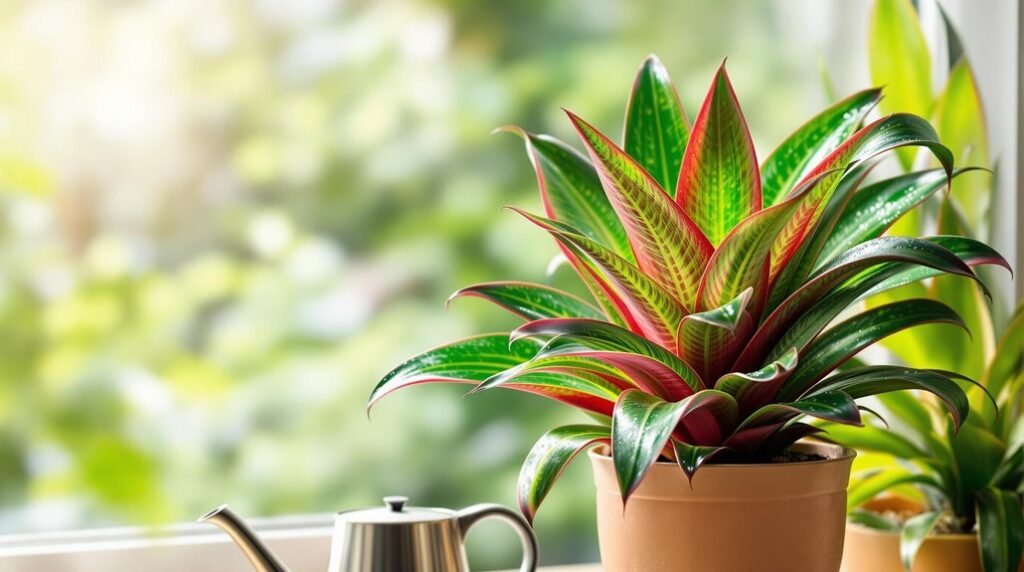If you want your bromeliad to thrive indoors, you’ll need to balance light, water, and humidity carefully. Too much direct sun can scorch the leaves, while too little light will stunt growth. Watering isn’t as simple as it seems either—knowing when and how to hydrate your plant can make all the difference. Before you set your bromeliad on the windowsill, there are a few key care tips you should understand.
Light and Environmental Conditions for Bromeliads
A bromeliad thrives best in bright, indirect light, so placing it near east- or north-facing windows helps mimic its natural forest canopy habitat.
Bromeliads need this light level to develop colorful foliage and encourage blooming. Avoid direct sunlight since it can scorch leaves, yet don’t let the plant suffer in low light conditions, which cause stretched, greener leaves and poor growth.
Proper light is key for vibrant leaves and blooming; too much sun scorches, too little stunts growth.
While bromeliads tolerate some shade, they perform most effectively with adequate brightness.
Besides light, maintaining humidity around 50-70% is crucial, reflecting their tropical natural habitat.
Seasonal changes may slow growth, so you’ll want to adjust your care accordingly.
Watering Practices and Soil Requirements
Keeping your bromeliad healthy means paying attention not only to light and humidity but also to how you water it and the soil you use. Proper watering practices prevent root rot and promote growth.
Bromeliads thrive in well-drained soil, so choose a potting mix with organic matter like orchid bark, peat moss, and perlite. Use rain, filtered, or distilled water, avoiding tap water high in salts. Keep the central cup filled and flush it monthly to prevent buildup. Adjust watering frequency based on filtered sunlight exposure and humidity.
- Water monthly, checking soil dryness before watering
- Use a slightly acidic, well-drained potting mix
- Flush and refill the central cup every 1-2 months
- Repot bromeliads every 4-5 years with a slightly larger pot
Fertilization and Humidity Management

How often should you fertilize your bromeliad to keep it thriving without causing damage? Use a balanced, water-soluble fertilizer diluted to 1/4 strength once a month during spring and summer.
Over-fertilization can cause brown leaf tips, leaf burn, and stunt growth, so monitor your plant’s response carefully.
For humidity, bromeliads thrive best at 50-70%. Maintain this by regular misting, placing pebble trays filled with water nearby, or using a humidifier.
Water the soil when the top inch feels dry, and keep the central cup filled with fresh water, changing it often to prevent stagnation.
Using distilled or rainwater is best since tap water salts can harm your bromeliads over time.
Proper fertilization and humidity management promote healthy growth and vibrant foliage.
Propagation and Pruning Techniques
While bromeliads require minimal pruning, focusing on removing dead leaves and spent flower spikes can greatly boost their health and appearance.
For propagation, you’ll work with pups—small offsets growing at the base of the parent plant. Wait until pups develop their own roots before transplanting to guarantee healthy growth.
Regular pruning during spring or summer reduces stress and prevents pest issues.
Keep these tips in mind:
- Remove dead leaves and spent flower spikes promptly
- Clean debris from the central cup to avoid rot
- Separate pups when they reach one-third the parent plant’s size
- Transplant pups only after roots have formed
Following these propagation and pruning techniques keeps your bromeliad thriving and vibrant indoors.
Common Issues and Pest Control Strategies

If you notice brown spots on your bromeliad’s leaves or mushy roots, overwatering is likely the culprit, leading to root rot. To prevent this, guarantee good drainage and let the soil dry between waterings.
Pests like mealybugs and scale can threaten your plant health, so regular monitoring is crucial. Look for sticky residue or webbing as signs of infestation. For pest control, wipe off pests with alcohol or remove them manually. Using organic pesticides, such as neem oil, helps manage pests without harming your bromeliad.
Maintaining humidity between 50-70% discourages pest problems; mist leaves or use pebble trays to support this. Keeping a clean environment and practicing consistent monitoring will keep your bromeliad thriving and free from common issues.
Frequently Asked Questions
How to Keep Bromeliads Alive Indoors?
You’ll want to place your bromeliad in bright, indirect light and water its central cup regularly. Keep humidity high by misting, use well-draining soil, and watch for pests to keep it healthy indoors.
How Do You Care for a Bromeliad Plant as a Houseplant?
Did you know bromeliads can hold up to 1/2 cup of water in their central cup? You’ll keep yours thriving by providing bright, indirect light, watering the cup regularly, using well-draining soil, and maintaining humidity.
How Do You Get Bromeliads to Rebloom Indoors?
To get bromeliads to rebloom indoors, you’ll provide bright, indirect light, keep humidity around 50-70%, water the central cup regularly, fertilize sparingly during growing season, and encourage pups to mature for future blooms.
Where Is the Best Place to Put a Bromeliad Plant?
You should place your bromeliad in bright, indirect light near an east or north-facing window. Keep it away from direct sun and cold drafts, ensuring humidity stays around 50-70% for healthy growth and vibrant blooms.
Final Thoughts
With the right care, your bromeliad can thrive beautifully indoors. By providing bright, indirect light, maintaining proper humidity, and watering thoughtfully, you’ll enjoy vibrant, long-lasting blooms. Don’t forget to feed it gently and keep pests at bay with regular checks. Ready to transform your space with a splash of tropical color? With just a little attention, your bromeliad will reward you with stunning growth and endless charm. Why wait to bring that beauty inside?
